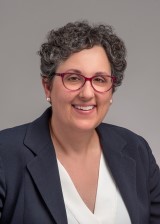Pediatric health clinicians and other advocates can take action to expand access to comprehensive sex education, contraception, and abortion for all youth.
Perspective

Yael Benvenuto Ladin, Youth activist
Think about the last time you needed reproductive healthcare: where you were, who you were with, and why you sought care. Did you get what you needed? How far did you travel? How much did it cost to get there and to pay for your care? How did you figure out where to go and what to ask for? Did you expect to be listened to, treated with respect? Did you have to hide that you sought care? For many of us, these concerns are not restricted by age, and for youth, especially, encountering these hurdles can be overwhelming. Young people are so much more likely to be in the dark about critical and urgent issues: bodily processes, available and appropriate care, where it can be found, and how to ask for it. For youth of color, queer and trans youth, young people from rural communities and facing economic injustice and inequity, the fear, barriers, and risks involved in seeking out reproductive healthcare are compounded. This is what compels me to advocate and provide support for youth access.
As a young person advocating for youth access to reproductive healthcare, I have a message for you. We need you, allies, and we appreciate you so much. We also know what we need, what we deserve, and how we want to get there. We have skills, energy, and power. Young people are the experts on youth experience, we know the barriers we face and how it feels to come up against them. Listening to our contributions and uplifting them is recognizing that you have the ability to do what many others do not: take us seriously. These issues are critical– we are fighting for our autonomy, our right to safe, comprehensive, trauma-informed care and our right to education. You– the pediatrician, the youth advocate, the public health professional, the policy maker– can take our words, our work, and our vision for youth access to sexual and reproductive healthcare into spaces that reject and overlook us.

Krishna Upadhya, MD, MPH, FAAP
Adolescents and young adults need access to developmentally appropriate sexual and reproductive health care and information in order to achieve optimal health. As all pediatricians know, the onset of romantic relationships and sexual experience are developmentally expected during adolescence. Having the skills and support needed to navigate these milestones sets the foundation for a key aspect of adulthood. Comprehensive sex education and services including contraception, prevention and treatment of sexually transmitted infections, and pregnancy care, including abortion, support healthy adolescent development and have benefits to communities and society that are well documented around the globe. Those of us who work with young people also have many, rich anecdotal experiences to validate the data in personal terms.
Unfortunately, it is also very clear that too many people in the United States face unnecessary and unacceptable barriers to the sexual health information and services they need to be healthy. And while 2022 is a particularly acute inflection point for access, especially to abortion care, threats and barriers to this care and information have existed for decades. The barriers have also harmed some people more than others, with adolescents, people in historically disenfranchised and underserved racial groups and those with low incomes particularly impacted. Policies and practices restricting access to abortion and other sexual and reproductive health care and information are significant contributors to the poor reproductive health outcomes reflected in our national data: why maternal and infant mortality in the US occur at much higher rates than in other high income countries; why women who are Black are more than 4 times as likely to suffer maternal mortality than white women; and why young people account for almost 50% percent of sexually transmitted infections even though they only represent 25% of the sexually active population.
Pediatric health clinicians who work with families and young people are critical to changing the trajectory, improving sexual and reproductive health outcomes and advancing health equity. Pediatricians impact patients and their families directly with their care, provide subject matter expertise to schools and community organizations, and also can be powerful advocates with policy makers. As we think about what we can do to make change we must keep at the center what those who have experienced the greatest harms and barriers, including our young people, have been speaking up about and advocating for. Access to sexual and reproductive health care is essential because everyone should have the freedom and power to control their own body, decisions, and lives. Thank you for taking the time to engage with this resource and for doing what you can to ensure that all people can access the care and information they need to be their healthiest selves.
A call to action
Equitable access to comprehensive sex education, contraception, and abortion is a critical component of adolescent health. Pediatric health clinicians play an important role in supporting and expanding access to sexual and reproductive health care for all adolescents and young adults:
- Education: Educating self, colleagues, and other key partners about local/state laws on access to care, institutional policies surrounding delivery of care services, and identification of sexual and reproductive health organizations in the community for collaboration and referral opportunities.
- Promotion: Speaking out on the importance of equitable access to sexual and reproductive health care for youth, and educating patients and their families about sexual health, reproductive health, contraception, pregnancy options, abortion, and other related health services.
- Primary Prevention: Providing direct prevention interventions to support sexual and reproductive health of youth in clinical and community settings. Examples include addressing sextually transmitted infection (STI) and pregnancy prevention as a part of clinical services, talking with patients about healthy relationships, communication, and consent, talking with parents or caregivers of children and adolescents about having healthy discussions about puberty and sexuality with youth, providing options counseling to pregnant patients, combating misinformation about sexual health, speaking out against stigma, and raising awareness about the importance of sexual and reproductive health.
- Advocacy: Promoting policy priorities that impact your community, such as increasing access to affordable, effective, evidence-based sexual and reproductive health services, fostering healthy sexual development for youth and young adults, increasing payment and insurance coverage, building the sexual and reproductive health workforce, and developing the evidence base to address disparities. More information can be found in the Policy Priorities for Promoting Youth Access to Sexual and Reproductive Health Care.
- Partnerships: Collaborating with key partners, including but not limited to youth, families, schools, youth-serving organizations, school-based health clinics, and mobile clinic providers expands youth access to reproductive health care services and resources.
Key Terminology
For the purposes of this resource:
- The words “people” and “pregnant people” are generally used to describe individuals who are accessing sexual and reproductive health services, including comprehensive sex education, contraception, and abortion. The terms were chosen because they are inclusive to all people who access the full spectrum of health services, including cisgender women, cisgender men, people who identify as non-binary, and people who identify as transgender. Sometimes the word “women” is used when describing specific research or data that use that term to describe their study population.
- References to the term “pediatric health clinicians” are intended to include all health clinicians who provide sexual and reproductive health care to youth and young adults, including (but not limited to) pediatricians, pediatric medical subspecialists, pediatric surgical subspecialists, pharmacists, family physicians, obstetricians, gynecologists, subspecialists, mental and behavioral health professionals, nurses, nurse practitioners, physician assistants, medical assistants, school nurses, and any other clinician who provides health care to youth.
- Use of the terms “underresourced” and “underrepresented” when describing a population or community (eg, racial, religious, or cultural group) refers to a population or community whose access to institutional and structural power has been severely limited regardless of its relative population size.
- References to the term “parent/caregiver” are meant to include anyone who serves in a parental role in a young person’s life, including, but not limited to, adoptive parents, biological parents, foster parents, grandparents, stepparents, and guardians.
- References to “youth” and/or “young people” are meant to include all adolescents and young adults from 11 to 25 years in age.
- The phrase “Reproductive Justice” can be defined as the human right to maintain bodily autonomy, have children, not have children, and parent the children we have in safe and sustainable communities.
- Use of the term “Reproductive Health Care” encompasses comprehensive sexual education, contraception, and abortion.
- The use of the acronym “LGBTQ2S+” stands for lesbian, gay, bisexual, transgender, queer, two-spirit, and attempts to define individuals that do not experience the same power and privilege as individuals who are heterosexual and/or cisgender.
- References to youth with disabilities is referring to youth physical disabilities, intellectual disabilities, learning disabilities, chronic medical conditions, and/or autism. It’s important to note that every individual’s spectrum of ability ranges and each’s unique needs be considered when developing strategies that supports and expands an individual’s access sexual and reproductive health care.
Note: This resource is designed to support pediatric health clinicians and other youth advocates in supporting and expanding access to sexual and reproductive health care for all youth while also supporting the inclusion of reproductive justice in pediatric care. It is a dynamic document that is meant to provide information that is current, accurate and easy to understand. As a consumer of this resource, you may bring lived experiences, areas of specialized studies, professional positions, and/or passion to this space and are therefore a valuable partner in this work. If, while engaging with this resource, you notice an outdated link or a missing resource or tool, please complete this form and your request will be reviewed by AAP staff.
Last Updated
07/14/2023
Source
American Academy of Pediatrics